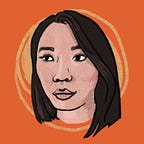Artist Robin Ha: “Everyone Feels Imposter Syndrome”
The “Cook Korean” author-illustrator says art book fairs aren’t just for selling books
Artist Robin Ha is the author of the New York Times bestselling comic cookbook “Cook Korean!” Based in Washington, D.C., she’s a regular exhibitor at local art fairs selling prints, books and zines. Her graphic memoir “Almost American Girl” is set to publish in 2020. She shared her thoughts about selling books and zines at the DC Art Book Fair over email.
What essentials do you always bring that first-timers forget or don’t realize they need?
- You need to bring small bills for change, which we call ‘float’ (about $50 of $1, $5 and $10 bills has worked for me). Also a Square reader if you have one. Having a sign with your payment types (credit cards or a Venmo username) is also helpful.
- I highly recommend bringing small snacks that you can easily munch on without making a mess on your fingers such as nuts, dried fruits and a large bottle of water. It is hard to get away from your table to find food during the festival.
- Tablecloth! Not all conventions provide a tablecloth, or they are usually just plain black ones. You want to bring something that will go well with your books. And also, those foldable bookstands to prop up your books so they are not all lying flat helps catch people’s eyes.
How should first timers think about printing and pricing?
It is good to look around the festival to see how others have priced merchandise similar to yours. If you price things too high, it’ll be hard to sell. But if your book took a long time and a lot of effort and money to make, you should price it to what seems fair to you. Just keep in mind that it’s harder to sell books priced higher than $25. Unfortunately, people expect books to be cheap, even though it takes months to create the contents. If you are selling expensive books, you’ll have to market it by explaining what is special about the book and how it’s made.
If the book is mass-printed via a professional printing service, it would go for a lower price than a similar book that is printed limited edition via riso printer or silkscreen. Color or black and white interior pages don’t seem to have that much impact on the price of the book these days. It’s how it’s printed and bound, and the quality of the paper that has more impact on the price of the books.
I would say to bring about 10 copies of each book to sell on average. If you’ve sold your books before, adjust for the ones you know sell better.
Do you have any advice regarding marketing, putting yourself out there or getting over imposter syndrome?
I think everyone feels imposter syndrome no matter what stage of career they’re in. Just know that every book is different and unique, and there are no books like yours out there. I try to focus on making connections with people who come by my table and to have a good conversation with them.
Being at the festival isn’t just about selling your books. I’ve had people message me after the show to hire me as an illustrator, guest speakers for their organization, or even became close friends. I try to be as genuine and friendly as possible as if I am at a party for art book enthusiasts and I usually end up having a great time at the show no matter what.
Marketing art is hard and I am still figuring it out for myself. It’s important to not feel too attached to your books or take it personally if people are not interested in your books. It is good to have an elevator pitch for each of your books, less than a minute long description that can catch people’s interest. If they still don’t pick up the book after your elevator pitch, just let them browse and move along. But if they actually pick up the book and look through it, you can give them more information on the book, and also recommend other books that are similar to it on your table.
How do you learn about upcoming opportunities to table? And, how do you figure out which events are the best fit if you’ve never attended?
I usually find out about shows through the grapevine. It’s important to cultivate a community of artists in your area. I follow a lot of people who are in the same business on Instagram and Twitter, and I pick up submission deadlines and new events through social media.
Starting out with shows that are inexpensive first and gradually working up to more expensive and well-known shows is a good strategy. DC Zinefest is a good place to start because the table fee is very cheap, and there’s no entrance fee for visitors. If you have never been to a show, Google it and see if others have blogged about them to see if they would be a good fit for you. Don’t be afraid to e-mail the organizer to ask them any questions.
This interview has been edited and condensed for length & clarity. Robin Ha will exhibit her work at the DC Zinefest on Saturday, July 20, from 11 a.m. to 5 p.m.
